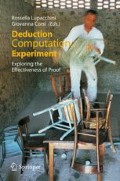Abstract
We address two questions:
-
what is the use of formal proofs?
-
how do we proceed from a formal proof to a computation?
Access this chapter
Tax calculation will be finalised at checkout
Purchases are for personal use only
Preview
Unable to display preview. Download preview PDF.
References
P. Aczel and M. Rathjen: Notes on Constructive Set Theory, Draft available from the Internet, http://www.cs.man.ac.uk/~petera/
M. Aschbacher: Highly complex proofs and implications of such proofs. Philosophical Transactions of the Royal Society A 363 (2005) pp 2401–2406
J. Avigad: Number theory and elementary arithmetic. Philosophia Mathematica 11 (2003) pp 257–284
J. Avigad: Mathematical Method and Proof. Synthèse 153 (2006) pp 105–159
J. Avigad, K. Donnelly, D. Gray and P. Raff: A formally verified proof of the prime number theorem. ACM Transactions on Computational Logic, 9, 1:2 (2007)
H. Barendregt: The Lambda Calculus. Its Syntax and Semantics (Elsevier, Amsterdam, 1984)
P. Bernays: Mathematische Existenz und Widerspruchfreiheit. In: Ètudes de Philosophie des Sciences en hommage à Ferdinand Gonseth, (Neuchatel, 1950) pp 11–25 (English Translation by W. Sieg, R. Zach and S. Goodman, available as Text No.19, Bernays Project)
P. Bernays: Die Schematische Korrespondenz und die idealieserte Strukturen. Dialectica 24 (1970) pp 53–66 (English Translation by E. Reck and C.Parsons available as Text No.27, Bernays Project)
A. Cantini: The axiom of choice and combinatory logic. Journal of Symbolic Logic 68 (2003) pp 1091–1108
A. Cantini: Remarks on applicative theories. Annals of Pure and Applied Logic 136 (2005) pp 91–115
L. Carroll: What the Tortoise said to Achilles. Mind 4 (1895) pp 278–280
E. Casari: Matematica e Verità. Rivista di Filosofia 78 (1987) pp 329–350
C. Cellucci: The nature of mathematical explanation, this volume (2008)
C. Cornaros and C. Dimitracopoulos: The prime number theorem and fragments of PA. Arch. Math. Logic 33 (1994) pp 265–281
L. Crosilla, H. Ishihara, P. Schuster: On constructing completions. Journal of Symbolic Logic 70 (2005) pp 969–978
S. Feferman: In the Light of Logic (Oxford University Press, Oxford 1998)
E. Friedgut (with an appendix by J. Bourgain): Sharp thresholds of graph prop-erties and the k-Sat problem. Journal of the American Mathematical Society 12 (1999) pp 1017–1054
E. Giusti: Ipotesi alla base dell’esistenza matematica (Boringhieri, Torino 1999)
A. Goerdt: A Threshold for Unsatisfiability. Journal of Computer and System Sciences 53 (1996) pp 469–486
J. Hafner and P. Mancosu: The Varieties of Mathematical Explanation. In: Visualization, Explanation, and Reasoning Styles in Mathematics, ed by K. Jorgensen et al. (Kluwer, Dordrecht 2005).
G. Hardy: A mathematician’s apology (Cambridge University Press, Cambridge, 1941)
22. B. Intrigila and R. Statman: Some results on extensionality in lambda calculus. Annals of Pure and Applied Logic 132 (2005) pp 109–125
R. Kahle: David Hilbert and functional self-application, preprint (2006)
U. Kohlenbach and P. Oliva: Proof mining: a systematic way of analysing proofs in mathematics. Proc. Steklov Inst. Math. 242 (2003) pp 136–164
U. Kohlenbach: Some Logical Metatheorems with Applications in Functional Analysis. Transactions of the American Mathematical Society 357 (2005) pp 89–128
G. Kreisel: Principles of proofs and ordinals implicit in given concepts. In: Intuitionism and Proof Theory, ed by J. Myhill, A. Kino, J. Myhill and R. E. Vesley (North Holland, Amsterdam 1970) pp 489–516
G. Lee: Phase Transitions in Axiomatic Thought, Ph. Thesis, Westfalische Wilhelms-Universität Mönster (2005)
G. Lolli: Capire una dimostrazione (Il Mulino, Bologna 1988)
R. S. Lubarski and M. Rathjen: On the constructive Dedekind reals. To appear in Logic and Analysis, published online: 18 February (2008) pp 1–22
S. Mac Lane: Despite physicists, proof is essential in mathematics. Synthèse 111 (1997) pp 147–154
P. Mancosu: Mathematical Explanation: Problems and Prospects. Topoi 20 (2001) pp 97–117
32. G. Pólya: Eine Erinnerung an Hermann Weyl. Mathematische Zeitschrift 126 (1972) pp 296–298
D. Prawitz: Natural Deduction: a Proof—theoretical Study (Almqvist and Wiksell, Stockholm 1965)
D. Prawitz: Philosophical Aspects of proof theory. In: Contemporary philosophy. A new survey, vol.I (Nijhoff, The Hague 1981) pp 235–277
Y. Rav: Why do we prove theorems. Philosophia Mathematica 7 (1999) pp 7–41
G. Rota: The phenomenology of mathematical beauty. Synthèse 111 (1997) pp 171–182
B. Russell: The regressive method of discovering the premises of mathematics. In: B. Russell: Essays on Analysis (London 1973) pp 272–283
S.G. Simpson: Subsystems of Second Order Arithmetic (Springer, Berlin Heidelberg New York 1999)
A. Weiermann: An application of graphical enumeration to PA. J. Symbolic Logic 68 (2003) pp 5–16
A. Weiermann: Analytic combinatorics, proof-theoretic ordinals, and phase transition for independence results. Ann. Pure Appl. Logic 136 (2005) pp 189-218
Author information
Authors and Affiliations
Editor information
Editors and Affiliations
Rights and permissions
Copyright information
© 2008 Springer-Verlag Italia
About this chapter
Cite this chapter
Cantini, A. (2008). On Formal Proofs. In: Lupacchini, R., Corsi, G. (eds) Deduction, Computation, Experiment. Springer, Milano. https://doi.org/10.1007/978-88-470-0784-0_2
Download citation
DOI: https://doi.org/10.1007/978-88-470-0784-0_2
Publisher Name: Springer, Milano
Print ISBN: 978-88-470-0783-3
Online ISBN: 978-88-470-0784-0
eBook Packages: Humanities, Social Sciences and LawPhilosophy and Religion (R0)

